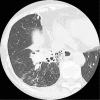The Effective Treatment of Lung Infection Due to Scedosporium prolificans with Voriconazole and Surgery
- PMID: 28420849
- PMCID: PMC5465417
- DOI: 10.2169/internalmedicine.56.7447
The Effective Treatment of Lung Infection Due to Scedosporium prolificans with Voriconazole and Surgery
Abstract
Scedosporium prolificans is a fungus that has demonstrated resistance against most currently available antifungal agents and which causes a rapidly disseminating and potentially fatal infection. A 68-year-old woman presented with a fever and consolidation in the lung field. Her symptoms and inflammatory reaction did not improve despite treatment with tazobactam/piperacillin, meropenem, and micafungin. Scedosporium prolificans was detected from the patient's bronchial lavage fluid, and we initiated treatment with voriconazole. Voriconazole was effective in shrinking the consolidation and suppressing the inflammatory reaction. The residual lesion was surgically resected because of the risk of systemic dissemination. The patient is currently alive without relapse or dissemination.
Keywords: Scedosporium prolificans; lung infection; surgery; voriconazole.
Figures






Similar articles
-
Prognostic factors in 264 adults with invasive Scedosporium spp. and Lomentospora prolificans infection reported in the literature and FungiScope®.Crit Rev Microbiol. 2019 Feb;45(1):1-21. doi: 10.1080/1040841X.2018.1514366. Epub 2019 Jan 10. Crit Rev Microbiol. 2019. PMID: 30628529
-
Nebulized voriconazole in infections with Scedosporium apiospermum--case report and review of the literature.J Cyst Fibros. 2014 Jul;13(4):400-2. doi: 10.1016/j.jcf.2013.10.014. Epub 2013 Nov 18. J Cyst Fibros. 2014. PMID: 24263169 Review.
-
Successful control of disseminated Scedosporium prolificans infection with a combination of voriconazole and terbinafine.Eur J Clin Microbiol Infect Dis. 2003 Feb;22(2):111-3. doi: 10.1007/s10096-002-0877-z. Epub 2003 Feb 14. Eur J Clin Microbiol Infect Dis. 2003. PMID: 12627286
-
Breakthrough lung Scedosporium prolificans infection with multiple cavity lesions in a patient receiving voriconazole for probable invasive aspergillosis associated with monoclonal gammopathy of undetermined significance (MGUS).Med Mycol J. 2011;52(1):33-8. doi: 10.3314/jjmm.52.33. Med Mycol J. 2011. PMID: 21441711
-
Scedosporium prolificans pericarditis and mycotic aortic aneurysm in a lung transplant recipient receiving voriconazole prophylaxis.Transpl Infect Dis. 2013 Apr;15(2):E70-4. doi: 10.1111/tid.12056. Epub 2013 Feb 6. Transpl Infect Dis. 2013. PMID: 23387799 Review.
Cited by
-
Management of pulmonary Scedosporium apiospermum infection by thoracoscopic surgery in an immunocompetent woman.J Int Med Res. 2020 Jul;48(7):300060520931620. doi: 10.1177/0300060520931620. J Int Med Res. 2020. PMID: 32614267 Free PMC article.
-
Scedosporiosis and lomentosporiosis: modern perspectives on these difficult-to-treat rare mold infections.Clin Microbiol Rev. 2024 Jun 13;37(2):e0000423. doi: 10.1128/cmr.00004-23. Epub 2024 Mar 29. Clin Microbiol Rev. 2024. PMID: 38551323 Free PMC article. Review.
-
Systemic Scedosporium apiospermum Infection Affecting Multiple Sites After Near-Drowning: A Case Report.Infect Drug Resist. 2024 Dec 20;17:5739-5744. doi: 10.2147/IDR.S483524. eCollection 2024. Infect Drug Resist. 2024. PMID: 39720616 Free PMC article.
-
Scedosporium spp lung infection in immunocompetent patients: A systematic review and MOOSE-compliant meta-analysis.Medicine (Baltimore). 2019 Oct;98(41):e17535. doi: 10.1097/MD.0000000000017535. Medicine (Baltimore). 2019. PMID: 31593129 Free PMC article.
References
-
- Husain S, Muñoz P, Forrest G, et al. . Infections due to Scedosporium apiospermum and Scedosporium prolificans in transplant recipients: clinical characteristics and impact of antifungal agent therapy on outcome. Clin Infect Dis 40: 89-99, 2004. - PubMed
-
- Tortorano AM, Richardson M, Roilides E, et al. . ESCMID and ECMM joint guidelines on diagnosis and management of hyalohyphomycosis: Fusarium spp., Scedosporium spp. and others. Clin Microbiol Infect 3: 27-46, 2014. - PubMed
-
- Nishimori M, Takahashi T, Suzuki E, et al. . Fatal fungemia with Scedosporium prolificans in a patient with acute myeloid leukemia. Med Mycol J 55: E63-E70, 2014. - PubMed
-
- Hatakeyama Y, Yamada Y, Furukawa K, et al. . Three cases of tsunami lung in which genus Scedosporium was isolated. Nihon Rinsyou Biseibutsugaku Zasshi (Journal of Japanese Society for Clinical Microbiology) 22: 289-297, 2012(in Japanese).
-
- Tintelnot K, Just-Nübling G, Horré R, et al. . A review of German Scedosporium prolificans cases from 1993 to 2007. Med Mycol 47: 351-358, 2009. - PubMed
Publication types
MeSH terms
Substances
LinkOut - more resources
Full Text Sources
Other Literature Sources

